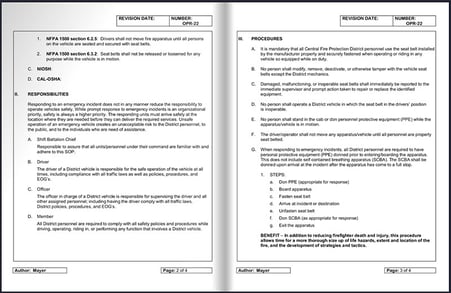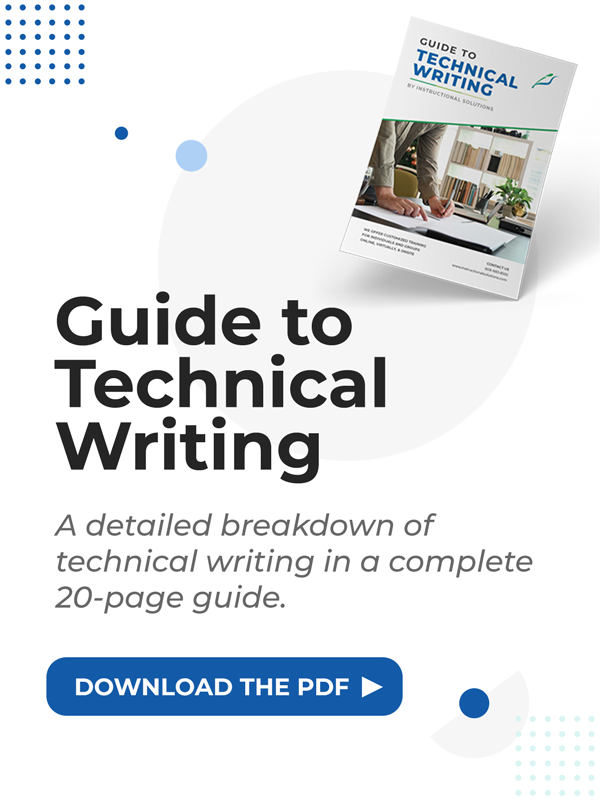11 Types of Technical Writing with Real Examples

Originally published May 19, 2022, updated June 18, 2025

Table of Contents
A technical writer is often tasked with creating various types of technical writing documents, which may include project documentation, general business writing (such as forms, templates, presentations, and bid documentation), marketing collateral, and training materials.
Technical documents or technical communications take many forms:
- User Guides/User Manuals
- Statements of Work
- Policies
- Standard Operating Procedure
- A Technical Email Sent to a Colleague
- Reports
- Specifications
- Bid Documentation
- Marketing Collateral
- API Documentation
Let’s explore each of these types of technical writing in detail (note that some overlap may occur between them) and discuss a few tips to improve your technical writing skills.
Master Technical Writing Today
Want to learn how to write any technical document like a Pro? Enroll in Our Online, Self-Paced, and Virtual Technical Writing Courses.
What is Technical writing?
Technical writing is the practice of communicating complex information clearly, concisely, and accurately. It converts specialized knowledge from fields such as engineering, IT, science, finance, or manufacturing into content that is easy for specific audiences to understand and use.
Unlike creative or academic writing, technical writing is practical in nature. Its primary purpose is to inform, instruct, or guide readers. Common examples include manuals, user guides, standard operating procedures (SOPs), technical reports, white papers, and online help systems.
Technical writing matters because even the most advanced product, system, or process is only effective if it’s well understood. Clear technical documentation reduces errors, increases efficiency, supports compliance, and improves the overall user experience.
It serves as a vital link between subject matter experts and the people who rely on that knowledge to do their jobs.
11 Types of Technical Writing With Examples
Technical writing spans a wide range of formats, each tailored to meet specific communication goals in different industries. From instructional documents to highly regulated reports, each type serves a unique purpose and audience.
Below are 11 key types of technical writing, along with examples to illustrate how they’re used.
1. User Guides/User Manuals
Also called a user manual, a user guide is a how-to document that breaks down key tasks and basic step-by-step instructions for the end-user to install, assemble, use, or troubleshoot a technical service or software. For example, you might receive basic assembly instructions for ARM core programming.
A wide variety of manual and guide types exist.
- Instruction manual
- Product manual
- Repair manual
- Policy manual
- Training manual
These documents are written with the assumption that the user has no technical knowledge or doesn't understand the technical terms of the topic.
Strong User Manual Example:
Adobe created an end-user manual or guide for newbies learning InDesign's features. The company provides step-by-step instructions on how to use the software to create beautiful graphic designs and elegant layouts. What it does well: This technical document is neatly organized with a table of contents, headings, and subheadings. Users can start at the beginning of the guide, or they can visit each section individually, depending on their questions.
What it does well: This technical document is neatly organized with a table of contents, headings, and subheadings. Users can start at the beginning of the guide, or they can visit each section individually, depending on their questions.
For example, users could begin clicking on sections to get an entire overview of InDesign. Or maybe they just want to create an ebook page. They can click on the corresponding section. Adobe includes clear instructions and images for each topic.
2. Statements of Work
A statement of work (SOW) is a legally binding document created for potential customers that breaks down a project's work management tasks. It outlines a project’s purpose, resources, schedule, milestones, and costs.
Here's how an SOW is typically set up:
- Introduction
- Purpose and objectives
- Scope of work (limitations of work)
- Schedule
- Deliverables
- Tasks
- Milestones
- Testing and compliance
- Cost and payment terms
These documents should be written with clear, direct language and all acronyms spelled out.
3. Policies
A policy outlines procedures and standards of behavior for a specific scope such as a company, product, or project. It includes requirements for the company, product, or project to succeed. An example could be a cybersecurity policy at a company.
For policies, try to use simple language rather than falling back on jargon. Remember that the document should be easy for your reader to understand.
4. Standard Operating Procedures
A standard operating procedure or SOP is a set of instructions on what steps to follow when performing some kind of operational task.
These steps ensure that laws, industry regulations, or a company's quality standards are met. SOPs are typically required in industries such as manufacturing, warehousing, and restaurants. SOPs involve complex topics and breaking down complicated subject matter.
Strong SOP Example:
The following SOP is for the Central Fire Protection District of Santa Cruz County's personal operating vehicles. It outlines the scope, purpose, definitions, etc., of using these vehicles to enforce safety laws and the safety of the drivers. 
What it does well: This SOP includes a brief overview of the purpose of the document (aka the Scope) at the top so the reader knows what to expect before reading. The information could also get confusing and dense, but the writer incorporated clear headings and white space through the use of bulleted lists and paragraphs to create digestible content.
5. Technical Email Sent to a Colleague
Emails can be technical writing, too! For example, you might explain step-by-step how to transfer users to a license management account and how to assign licenses to a user. You might also provide instructions on how to use a new software feature.
For a technical email, follow the same best practices that you would with any email such as including a greeting, bottom-line-on-top, headers, etc.
Learn more about best email writing practices here.
6. Reports
A report details the results of a project. A wide range of technical reports exists. Common types of technical reports include a feasibility report, laboratory report as a medical writer, and annual report.
For example, an annual report is a comprehensive technical document that a company presents to its shareholders to describe its activities from the previous year. The formal document typically includes a report from the company's Chairperson, CEO, corporate info, mission statement, etc.
Strong Technical Report Example:
Below is an example of this technical document from the Canadian Hearing Services (CHS). Presented for 2020-2021, the report includes an overview of CHS, its business activities, and in-depth financial information.
 What it does well: The annual report clearly updates shareholders on the company's condition while telling a story about how it pivoted during the pandemic. The content is polished and accurate, which is crucial as it's presented to a large audience. It also includes visuals and clear formatting, which keeps the reader engaged in the content.
What it does well: The annual report clearly updates shareholders on the company's condition while telling a story about how it pivoted during the pandemic. The content is polished and accurate, which is crucial as it's presented to a large audience. It also includes visuals and clear formatting, which keeps the reader engaged in the content.
7. White Paper
A white paper is standard in the technical world. It outlines a specific problem and provides solutions and benefits. It is a larger writing piece (typically 2,500 words) that deals with complex topics. It's also a widely used marketing tool.
White papers are data-centric, text-heavy documents. Due to a large amount of data and research, white papers are deep reads and tend to have a formal tone.
Strong White Paper Example:
For example, Redpoint Global created a white paper to explain the problem of brands connecting with customers through their preferred touchpoints. The white paper then offers a solution for using a customer data platform.  What it does well: The white paper provides persuasive stats to support its arguments. It clearly presents the problem, digging into three obstacles that prevent data-driven customer engagement with numbered lists. This approach then establishes Golden Records' customer data platform as a perfect solution. The white paper's title could be more descriptive and persuasive, but overall, it does a good job of outlining a specific problem.
What it does well: The white paper provides persuasive stats to support its arguments. It clearly presents the problem, digging into three obstacles that prevent data-driven customer engagement with numbered lists. This approach then establishes Golden Records' customer data platform as a perfect solution. The white paper's title could be more descriptive and persuasive, but overall, it does a good job of outlining a specific problem.
Related: How to Write and Format a White Paper: The Definitive Guide
8. Specifications Document
Technical specifications outline how you will approach a specific problem or issue. It also details the need for a solution, such as a system or a project. Here's a simple example of a product specification:
[Source]
With specifications, you know the unknowns, like potential risks or performance issues. Specifications help with collaboration, too, because you can agree on them, which improves the timeline for completing a project and prevents costly mistakes.
Related: How to Write a Software Specifications Document (SSD)
9. Bid Documentation
Bid documentation is technical documents that describe the elements of a construction project and are used to request proposals. Elements include estimates, specifications, and plans of a project. It gives bidders or suppliers the necessary info to place bids.
10. Marketing Collateral
Marketing collateral is a type of marketing communication that shows why your company, product, or online platform is the best on the market. It's not always technical, but it can be if you're sharing about technical information, such as software or hardware.
Types of marketing collateral include e-Books, case studies, and white papers. For example, an e-Book titled "Guide to C++ for Software Engineers" would be technical marketing collateral.
11. API Documentation
API documentation is a reference manual on how to effectively use and integrate the application programming interface (API). It's written for technical users who want to move forward in their software development. It shares specialized knowledge and schemas for tasks for software programs.
Strong API Documentation Example:
Stripe, the online payment processing company, provides comprehensive documentation on its API -- from Authentication to Request IDs.
 What it does well: Stripe's documentation includes definitions, helpful core resources, product information, and more. Categories are organized with subcategories. Helpful API screenshots are also included in the instructions.
What it does well: Stripe's documentation includes definitions, helpful core resources, product information, and more. Categories are organized with subcategories. Helpful API screenshots are also included in the instructions.
How to Use These Technical Writing Examples
Notice what these technical writing samples have in common: they are concise, clearly organized, and incorporate visuals as needed.
Whether you're writing end-user documentation, technical reports, or another type of company document, improve your technical content by following what these sample documents do well.
- Let your target audience and purpose guide your technical document.
- Follow a formal writing process to avoid getting stuck while drafting.
- Add clear visuals and graphics that complement your written work and support reader understanding.
- Edit, edit, edit. Ensure that your technical writing assignment is accurate, clear, and keeps the needs of your audience in mind.
Want to advance your technical writing career? We recommend taking a course to continually improve, hone your technical communication skills and share your knowledge as a subject matter expert. Check out our technical course options—with individualized instructor feedback—here.
Conclusion
Understanding the different types of technical writing is essential for anyone who needs to convey complex information clearly and effectively. Whether you're drafting a user manual, preparing a compliance report, or writing online help content, choosing the right format ensures your message is accurate, useful, and accessible to your audience.
This article explored the answer to “What is technical writing?” and provided a variety of technical writing examples across industries. From technical document examples like SOPs and white papers to an example of technical writing, such as a troubleshooting guide, each form has its place in effective communication.
By studying good technical writing examples and tailoring your approach to your readers’ needs, you can improve your documentation and become a more impactful communicator.
These examples of technical communication highlight the value of clarity, precision, and purpose, core elements of excellent technical writing.
Frequently Asked Questions (FAQs)
Why is it important to understand different types of technical writing?
Understanding the different types of technical writing helps you choose the most effective format for your message and audience. Each type—whether a manual, report, or procedure—serves a distinct purpose, and selecting the right one ensures clarity, accuracy, and usability.
How do user manuals differ from technical reports?
User manuals are instructional documents designed to help end users operate a product or system. They focus on step-by-step guidance. Technical reports, on the other hand, present findings, data, or analysis, often to internal stakeholders, and emphasize documentation of processes, results, or recommendations.
What skills are essential for technical writing?
Essential technical writing skills include the ability to write clearly and concisely, organize complex information logically, understand the subject matter, analyze data, and tailor content to the intended audience.
Strong research, editing, and attention to detail are also critical.
Can one document include multiple types of technical writing?
Yes, a single document can incorporate multiple types of technical writing.
For example, a product manual may include instructional content, troubleshooting procedures, and technical specifications. Blending formats ensures the document addresses different user needs effectively.
How do I improve my technical writing skills?
To improve your technical writing skills, practice writing with clarity and purpose, seek feedback, study strong technical writing examples, and take a technical writing course.
Understanding your audience and refining your editing and formatting skills will also significantly enhance your effectiveness.

